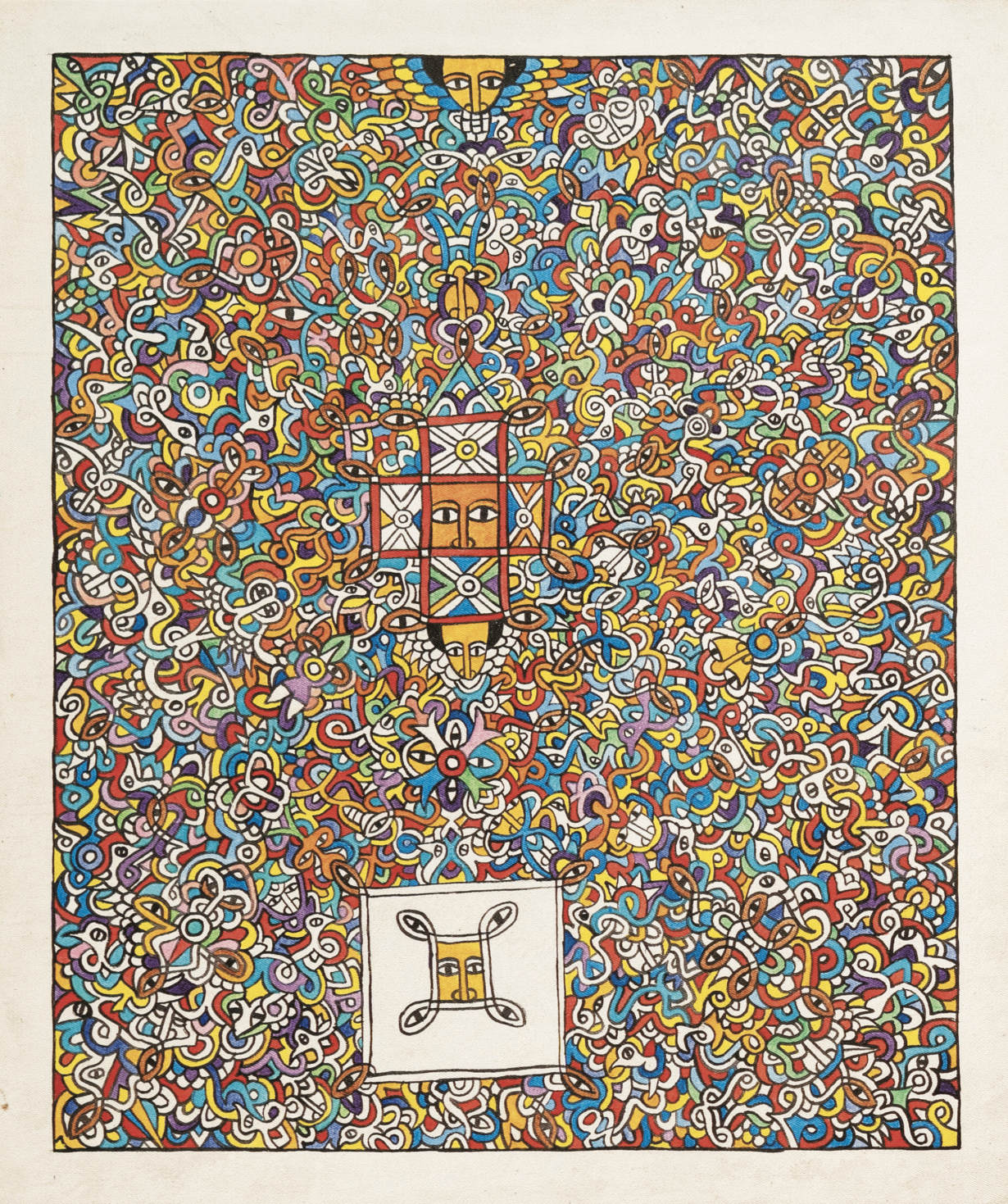Telsem Symbols and Imagery at Sharjah Art Museum questions how present-day art practices arising from long-gone native rituals are categorised and perceived

As the first institutional exhibition dedicated to the paintings of Ethiopian artist Henok Melkamzer, this survey of over 100 works (all untitled and made between 2013 and 2024) questions how present-day art practices arising from long-gone native rituals are categorised and perceived. Specifically, the exhibition seeks to resituate the ancient Ethiopian tradition of telsem, which, although adapted by living artists such as Melkamzer, has long been framed (by Western critics) in terms of anthropology rather than art history. The Amharic word telsem, which in English translates as ‘talisman’, describes an occult drawing or, perhaps more accurately, a type of graphic design based on astrological predictions and a precise system of structural components. For instance, the vibrant seven-colour palette that dominates the works here is representative of the seven vowels of the Ge’ez alphabet (the original Ethiopian script that is now only used by the Ethiopian Orthodox Church) as well as the days of the week. Similarly, the same set of lively symbols recur in these pictures, from eight-pointed stars and bird heads to crescent moons and pairs of eyes.
Originally taking the form of intricately inscribed scrolls to be worn on the body, these bespoke creations were commissioned by those seeking respite from illness and were understood as magical objects that would eradicate evil spirits. By the nineteenth century, millions of these healing scrolls were in use, despite obstacles put in place by emperors who punished those who relied on amulets and debteras (church scholars who have not been ordained due to their interest in non-Christian beliefs, such as fortune-telling). In recent decades, the use of scrolls and comparable therapeutic aids have declined considerably, perhaps due to what Melkamzer has called a ‘satellite infection’, alluding to the country’s embrace of foreign cultures at the expense of its own heritage. The conflation of telsem with witchcraft has also remained pervasive, meaning that responses to it can be suspicious in nature.
Critically, the tradition of making telsem extends, for the most part, generationally, through blood relatives – and only to those who are considered trustworthy (the mysterious rules through which these designs operate, though decipherable to only a few, are nonetheless to be guarded). So while students at the Ale School of Fine Art and Design in the country’s capital might try to emulate telsem, they lack the depth of knowledge that characterises it (also, to note: teaching at the school focuses on European art history). Melkamzer, who resides and works in the highlands overlooking Addis Ababa, was trained over several years by his father and grandfather; both telsem healers by trade. In the hands of Melkamzer, though, this practice of devising complex images has taken a different course. While his foundational understanding of telsem informs the works shown here (many incorporate numerical calculations and are guided by the Ethiopian calendar), they ultimately seek to expand the possibilities of the medium. Going by their deeply varied compositional strategies, many of which veer away from convention, the artist’s endeavours are evidently as much about formal experimentation as they are about articulating a remnant of Ethiopian visual culture in the present moment. In his handling of the artform, then, Melkamzer insists on just that: what he is making should be understood as pure painting.

To make this point, the exhibition opens with an entirely abstract work – the most minimalist of the group. Its surface has been divided into a grid of six squares using a pencil-thin line, onto which five circles have been overlaid or incorporated. Later on, the shape is explored again in a small group of paintings that have been hung together. Usually used as a framing device for a symbol, such as a sun face, these canvases feature circles that have been saturated with fluorescent yellow and white paint respectively, positioned as the focal point of each painting. In the same way, a handful of canvases drenched in black each depict a letter from the Ge’ez script, made visible with big, translucent brushstrokes, the textures of which illuminate the pictorial qualities of these symbols.
In line with these details, Melkamzer’s reorientation of telsem is also noticeable on two other fronts: parchment has been replaced with canvas; plant pigment with acrylic paint. The scale of the works range from small squares to monumental rectangles that reach three metres in height. Many canvases are covered in an endless pattern of vines that seamlessly interlock, creating a dense matrix that functions both as a backdrop and the central subject of the work. The motif is a vital facet of telsem, signifying the forces that connect humans with the planet, and Melkamzer’s ideas are at their most developed in some of the largest paintings that probe how the background and foreground interact. In one, the vines are eclipsed by a network of brightly coloured squares that appear to float on top of the maze underneath. Another is an exercise in symmetry, with a dizzying number of elements all existing on the same plane.
The exhibition brings attention to an artist who possesses undoubtable skill, but the question is whether it will help to change perceptions of telsem, specifically in terms of how it is allowed to function as a traditional cultural practice. Melkamzer’s work should be positioned within the context of contemporary African painting – a practice, he shows, that can draw on ancient traditions, resulting in work that does not need to be defined according to Western art history.
Telsem Symbols and Imagery at Sharjah Art Museum, through 16 June